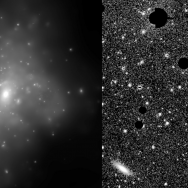Some kind of invisible material is out there affecting the motions of stars and galaxies, but thus far, no one has been able to directly detect the substance—called dark matter—itself. But some are hoping that we can tap the growing field of quantum science to finally find it.
Scientists at the U.S. Department of Energy’s Fermi National Accelerator Laboratory and the University of Chicago have demonstrated a new technique based on quantum technology that will advance the search for dark matter, which accounts for 85% of all matter in the universe.
“We know that there’s a huge amount of mass all around us that isn’t made of the same stuff you and I are made of,” said Fermilab scientist Aaron Chou, co-author of a paper published in Physical Review Letters on the new technique. “The nature of dark matter is a really compelling mystery that a lot of us are trying to solve.”
In particular, there are two kinds of subatomic particles that scientists have hypothesized as possible ways that dark matter could appear. The collaboration has developed new devices based on quantum computing bits that will be able to detect the weak signals emitted by either of these particles, if they exist: one called an “axion,” and the other called a “hidden photon,” a particle that possibly interacts with the photons— particles of light—of the visible universe.
The technique now demonstrated by the Fermilab-University of Chicago team could enable searches for dark matter to proceed 1,000 times faster than previous methods.
Using light to detect dark particles
Physicists have made little progress in detecting axions since their existence was proposed more than 30 years ago.
“Experiments using conventional techniques were just nowhere near what they needed to be for us to be able to detect higher-mass axion dark matter,” Chou said. “The noise level is way too high.”
But over the past decade, scientists have become increasingly good at harnessing the properties of quantum mechanics, the laws that govern the strange behavior of particles at the smallest levels of the universe, in order to create new technology. One such achievement is a “qubit,” or quantum computing bit. These can be incredibly sensitive to even the smallest perturbations—which is exactly what you want in a detector.
In the team’s new technique, qubits are designed to detect the photons that would be produced when dark matter particles interact with an electromagnetic field. A specially built device called a superconducting cavity provides a way to accumulate and store the signal photon. The qubit, inserted into the cavity, then measures the photon.
The technique will benefit the search for any dark matter candidate because when invisible particles convert into photons, they can be detected.
The key to the technique’s sensitivity is its ability to eliminate false-positive readings, the scientists said. Conventional techniques destroy the photons they measure. But the new technique can probe the photon without destroying it. Making repeated measurements of the same photon, over the course of its 500-microsecond lifetime, provides insurance against erroneous readings.
“To make a measurement of the photon once with the qubit takes about 10 microseconds, so we can make about 50 repeated measurements of the same photon within its lifetime,” said Akash Dixit, a doctoral student in physics at the University of Chicago and co-author.
The Fermilab-University of Chicago team’s technique also reduces the noise that hides the signal.
“It’s a much more clever and cheaper way to get the same large improvements in sensitivity,” Chou said. “Now, the level of the static noise has been reduced by so much that you have a chance to actually see the very first small wiggles in your measurements due to the very, very tiny signal.”
“Where the conventional method may generate one photon of noise with every measurement, in our detector you get one photon of noise every thousand measurements you make,” Dixit said.
Dixit and his colleagues adapted their technique from one developed by atomic physicist Serge Haroche, who shared the 2012 Nobel Prize in Physics for his feat.
Ferreting out axions and hidden photons
Superconducting microwave cavities are vital to the new technique. The cavity used in the experiment is made of highly pure—99.9999%—aluminum. At extremely low temperatures, the aluminum becomes superconducting, a property that extends the longevity of quantum bits, which by their nature are short-lived.
“The benefit we get is that, once you—or dark matter—puts a photon in the cavity, it’s able to hold the photon for a long time,” Dixit observed. “The longer the cavity holds the photon, the longer we have to make a measurement."
The technique is 36 times more sensitive to the particles than the quantum limit, a benchmark of conventional quantum measurements.
If axions exist, the current experiment provides a one-in-10,000 chance that it would detect a photon produced by a dark matter interaction.
“To further improve our ability to sense such a rare event, the temperature of the photons needs to be lowered,” said David Schuster, associate professor of physics at UChicago and a co-author of the new paper. Lowering the photon temperature will further increase sensitivity to all dark matter candidates, including hidden photons.
The photons in the experiment have been cooled to a temperature of approximately 40 millikelvins (minus 459.60 degrees Fahrenheit), just a touch above absolute zero. The researchers would like to go as low as the operating temperature of 8 millikelvins (minus 459.66 degrees Fahrenheit). At this point, the environment for searching for dark matter would be spotless, effectively free of background photons.
“While there’s definitely still a ways to go, there’s reason to be optimistic,” said Schuster, whose research group will apply the same technology to quantum computing. “We’re using quantum information science to help the dark matter search, but the same kind of background photons are also a potential error source for quantum computations. So this research has uses beyond fundamental science.”
Schuster said the project provides a nice example of the type of collaboration that makes sense to do between a university lab and a national lab.
“Our university lab had the qubit technology, but in the long term by ourselves, we were not really able to do any kind of dark matter search at the level needed,” he said. “That’s where the national-lab partnership plays an important role.”
The payoff from this cross-disciplinary effort could be huge.
“There’s just no way to do these experiments without the new techniques that we developed,” Chou said.
Citation: “Searching for Dark Matter with a Superconducting Qubit,” Dixit et al., Physical Review Letters, April 8, 2021.
Funding: Heising-Simons Foundation, U.S. Department of Energy High-Energy Physics QuantISED program.
—Adapted from a story by Steve Koppes first published by Fermi National Accelerator Laboratory.

